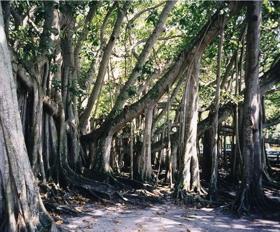From Wikipedia:
In Hinduism, the leaf of the banyan tree is said to be the resting place for the God Krishna, who, after consuming all the universe during the time of destruction, absorbs everything created and turns himself to a child as small as he could fit into the tiny leaf of the banyan tree and keeps floating in the void space, until he himself decides to recreate everything back out from him. Parallels have been drawnbetween this story and the pulsating theory in modern physics which hypothesizes that the universe expands and contracts in a series of Big Bangs and Big Crunches.
- In the Bhagavat Gita Krishna said “There is a banyan tree which has its roots upward and its branches down, and the Vedic hymns are its leaves. One who knows this tree is the knower of the Vedas.” (Bg 15.1) Here the material world is described as a tree whose roots are upwards and branches are below. We have experience of a tree whose roots are upward: if one stands on the bank of a river or any reservoir of water, he can see that the trees reflected in the water are upside down. The branches go downward and the roots upward. Similarly, this material world is a reflection of the spiritual world. The material world is but a shadow of reality. In the shadow there is no reality or substantiality, but from the shadow we can understand that there is substance and reality.
- Elsewhere in the Bhagavad Gita, Krishna says:
Of all trees I am the banyan tree, and of the sages among the demigods I am Narada. Of the Gandharvas I am Citraratha, and among perfected beings I am the sage Kapila.(10.26)
- The banyan tree is also considered sacred and is called “Vat Vriksha” in Sanskrit, in Telugu; Marri Vrikshamu and in Tamil known as: ‘ஆல மரம்’ ; Ala Maram. God Shiva as Dakshinamurthy is nearly always depicted sitting in silence under the banyan with rishis at his feet. It is thought of as perfectly symbolizing eternal life due to its seemingly unending expansion.
- In modern parlance in the Hindi language, it is known as Bargad, Vatavriksh, and Barh.
- Buddha is believed to have achieved enlightenment in Bodhgaya in India while meditating under a banyan tree of the species Sacred Fig. The tree is known as Bodhi Tree
- In Buddhism‘s Pali canon, the banyan (Pali: nigrodha)[9] is referenced numerous times.[10] Typical metaphors allude to the banyan’s epiphytic nature, likening the banyan’s supplanting of a host tree as comparable to the way sensual desire (kāma) overcomes humans.[11]
- In many stories of Philippine Mythology, the banyan, (locally known as balete or balite) is said to be home to a variety of spirits (diwata and engkanto) and demon-like creatures (among the Visayans, specifically, the dili ingon nato, meaning “those not like us”). Maligno (Evil spirits, from Spanish for ‘malign’) associated with it include the kapre (a giant), duwende (dwarves), and the tikbalang (a creature whose top half is a horse and whose bottom half is human).[12] Children at a young age are taught never to point at a fully mature banyan tree for fear of offending the spirits that dwell within them, most especially when they are new to the place. Filipinos would always utter a respectful word or two to the spirits in the banyan tree when they are near one, walking near or around it to avoid any harm. Nearly every Filipino believes that provoking the spirits in a banyan tree can cause you great harm, illness, misfortune, untold suffering and death.
- In Guam, ‘Chamorro people believe in tales of taotaomona, duendes and other spirits. Taotaomona are spirits of the ancient Chamorro that act as guardians to banyan trees.[13]
(Picture credits: Von Ahoerstemeier - Eigenes Werk, CC BY-SA 3.0, https://commons.wikimedia.org/w/index.php?curid=287383)




Add new comment